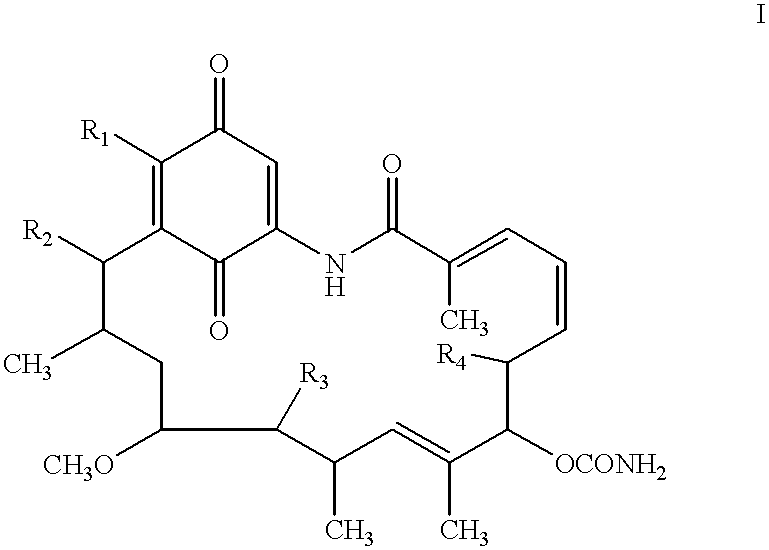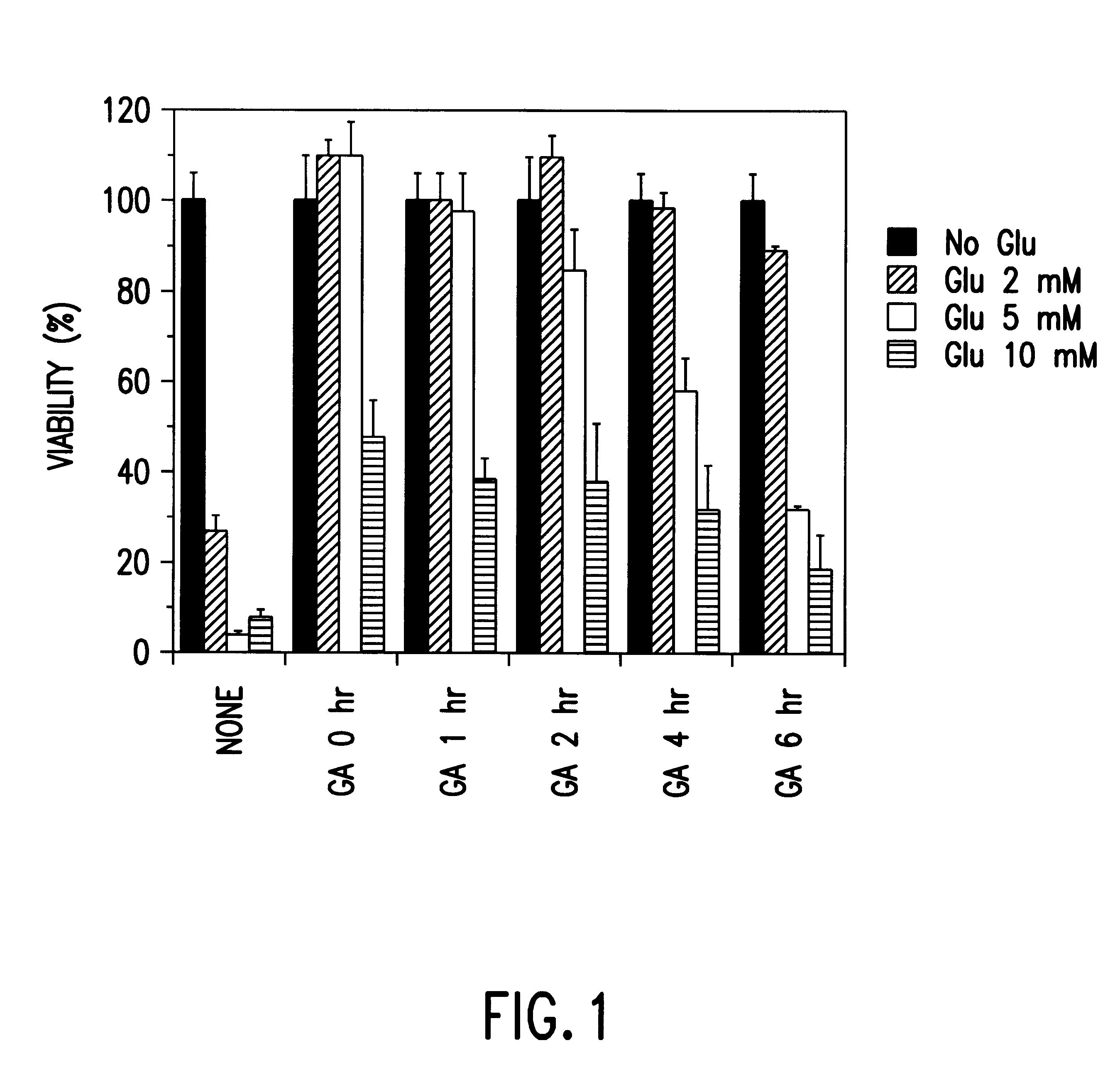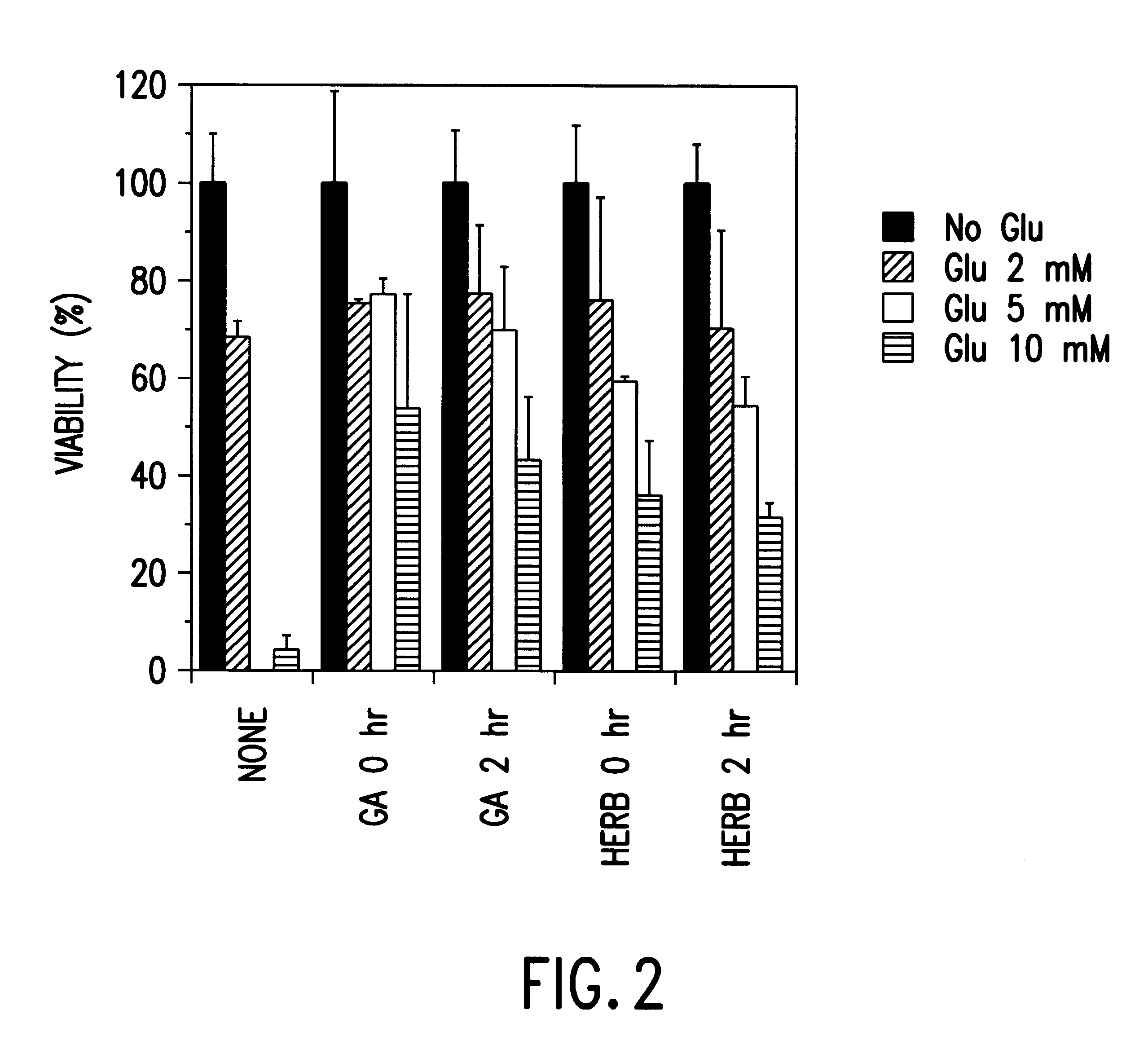Benzoquinoid ansamycins for the treatment of cardiac arrest and stroke
a technology of ansamycin and benzoquinoid ansamycin, which is applied in the field ofbenzoquinoid ansamycin for the treatment of cardiac arrest and stroke, can solve the problems of not being able to achieve pharmacologically acceptable manipulation of heat shock protein expression, cell death by necrosis, and often delayed response to oxidative stress
- Summary
- Abstract
- Description
- Claims
- Application Information
AI Technical Summary
Benefits of technology
Problems solved by technology
Method used
Image
Examples
example 2
Geldanamycin Protects HT22 Cells from Glutamate-Induced Cytotoxicity
HT22 cells were seeded on 60 mm tissue culture dishes at 300,000 cells per dish and grown overnight. Cells were then incubated in the presence of 5 mM glutamate for 20 hours. 5 Geldanamycin (0.1 .mu.g / ml) was added either at the same time, or 1, 2 or 6 hours after the addition of glutamate. Phase contrast images demonstrated that treatment of HT22 cells with 0.1 .mu.g / ml GA led to protection from glutamate-induced oxidative toxicity. After 24 hours of glutamate treatment, extensive cell death was visible both by inspection of HT22 cell cultures under light microscopy and as assessed by trypan blue staining. Treatment with GA alone appeared to reduce HT22 cell growth rate, but did not lead to cell death when assessed after 24 hours. These results demonstrate that Geldanaamycin protects HT22 cells from glutamate-induced cytotoxicity, even when added after glutamate. In order to provide a more accurate assessment of gl...
example 3
Glutamate-induced Depletion of Glutathione
Levels is not Reversed by Geldanamycin Treatment
Cellular glutathione (GSH) levels were measured in HT22 cells as described previously by Kane (1993) Science 262:1274. Briefly, HT22 cells were seeded onto 96-well plates at 20,000 cells per well and grown overnight. Cells were then treated with 5 mM glutamate (Glu) and / or 0.1 .mu.g / ml geldanamycin (GA) for 2, 4, 6 or 8 hours. Monochlorobimane was added to 40 .mu.M and following an additional 30 minutes of incubation, fluorescence at 460 nm in response to excitation at 395 mn was measured using a Perkin Elmer fluorescence plate reader. Values represent the average of triplicate experiments.+-.S.D.
It had been suggested that an early event in glutamate-induced oxidative toxicity in HT22 cells is the depletion of cellular glutathione levels which reflects intracellular oxidative stress (Li et al., supra). In the present example, the reported protracted time course of glutathione depletion in gluta...
example 4
Geldanamycin Inhibits Glutamate-Induced Apoptosis
Since oxidative glutamate toxicity in HT22 cells has the characteristics of programmed cell death, the present example was performed to determine whether the protective effects of GA result from a disruption in the apoptotic program. HT22 cells were treated with 5 mM glutamate (Glu) for 20 hours. 0.1 .mu.g / ml geldanamycin (GA) was added either at the same time as glutamate, or 1, 2 or 6 hours after the addition of glutamate. Controls included HT22 cells not treated with Glu or GA and cells treated with GA alone. Genomic DNA was prepared as described by Ausubel et al.; eds, Current Protocols in Molecular Biology, Vol. 2 John Wiley and Sons, Inc., Boston, 1994.
Internucleosomal DNA cleavage, a hallmark of apoptosis, was detected in HT22 cells following a 20 hour treatment with glutamate. Untreated HT22 cells, or cells treated with GA alone, were not subjected to this type of characteristic genomic DNA cleavage. Consistent with its protec...
PUM
| Property | Measurement | Unit |
|---|---|---|
| concentration | aaaaa | aaaaa |
| pH | aaaaa | aaaaa |
| time | aaaaa | aaaaa |
Abstract
Description
Claims
Application Information
 Login to View More
Login to View More - R&D
- Intellectual Property
- Life Sciences
- Materials
- Tech Scout
- Unparalleled Data Quality
- Higher Quality Content
- 60% Fewer Hallucinations
Browse by: Latest US Patents, China's latest patents, Technical Efficacy Thesaurus, Application Domain, Technology Topic, Popular Technical Reports.
© 2025 PatSnap. All rights reserved.Legal|Privacy policy|Modern Slavery Act Transparency Statement|Sitemap|About US| Contact US: help@patsnap.com



